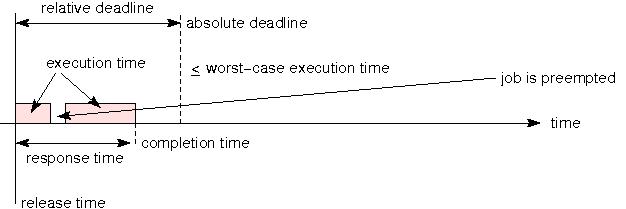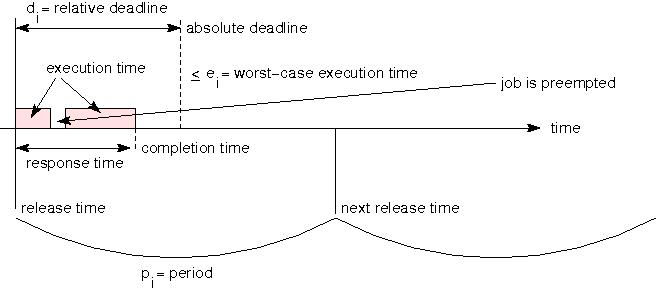Introduction to Periodic Tasks
This material is mostly covered in Chapter 3 of Jane Liu's text.
Jobs
- schedulable unit of work
- allocated processor time and other resources
- periodic task defines an infinite sequence of jobs
Job Release Times, Deadlines, Timing Constraints

- release time = time at which job becomes available for
execution
- completion time = time at which execution of job completes
- response time =
length of time between release and completion times
- deadline (absolute) =
time by which execution of job is required to complete
- deadline (relative) =
length of time between release time and absolute deadline
- feasible interval/window =
time between release time and absolute deadline
- lateness =
response time - relative deadline
- tardiness =
max (0, response time - relative deadline)
- slack = laxity =
remaining time to deadline - remaining compute time
Execution Time of Job, and WCET
- cannot be predicted exactly (is random variable)
- assumed to be constrained by a range [e-i,e+i]
- ei generally stands for the upper bound, known as the
worst-case-execution time (WCET)
- WCET is needed for theory to work
- an accurate WCET bound is hard to obtain in practice
See notes on measuring absolute event times and durations.
Tasks
- related set of jobs
- normally, the jobs of each task must be executed serially
(an implicit precedence constraint)
- set of tasks is normally fixed
- except at mode changes
- or in systems with admission control
Periodic Task
models workload typically associated with feedback-loop controller
- input sensor values
- compute new actuator values
- output new actuator values
- wait until next period
- go back to (1) and repeat

Periodic task abstraction
Each periodic task is characterized abstractly by three constants:
- period: pi
- worst-case execution time: ei
- relative deadline: di
- implicit deadline: di=pi
- constrained deadline: di≤i
- unconstrained deadline: arbitrary di
utilization of task τi, ui = ei / pi
density of task τi, ui = ei / min(pi,di
Periodic task sets
- finite collection of (independent) periodic tasks
- hyper-period of task set = LCM of all task periods
- execution time emax = maximum execution time of tasks
- utilization time umax = maximum utilization of tasks
- utilization time usum = sum of utilizations of tasks
Some generalizations of the periodic model
Phasing:
- tasks are in phase if they all have the same
first release time
- otherwise, the release times have non-zero offsets
Release-time jitter:
- amount of uncertainty or variation in release time
e.g., release time may be a range [r-i,r+i]
- Complex jobs: may have several subjobs, with precedence constraints
Completion-time jitter is also of interest, but is determined by the scheduler as
well as the workload.
Short deadlines can be used to control completion time jitter.
Delayed release times and short deadlines can also be used to force
ordering of jobs, to implement precedence constraints.
Liu's Periodic Tasks (called sporadic tasks by most authors)
- period pi = minimum time between releases of jobs
- most authors require that periodic tasks have a constant
inter-release interval, and use the term "sporadic" for what Liu
calls periodic
Liu's Aperiodic and "Sporadic" Tasks
- both have jobs released at random times
- characterized by distribution of inter-release times
- release times also called arrival times
- interarrival times may vary widely
- interarrival times and execution times are identically distributed RVs
- aperiodic ↔ soft deadlines
- sporadic ↔ hard deadlines
Liu diverges from most other authors here. The usual convention, which
I will follow in this course, is:
- periodic ↔ constant inter-arrival times
- sporadic ↔ lower bound on inter-arrival times
- aperiodic ↔ arbitrary inter-arrival times
Preemptivity
- preemptible job : can be interrrupted and processor assigned to another
job, at any time
- non-preemptible job : once started must be completed without assigning processor
to any other job
Laxity Type
- hard : deadline or other timing constraint must always be satisfied
- soft : deadline or other timing constraint need not always be satisfied
Schedule
- mapping : (job, time_instant) → processor
- job cannot be assigned to more than one processor at a time
- a processor cannot be assigned more than one job at a time
- a job cannot run before its release time
- the total amount of processing time assigned to a job does not
exceed its (actual or maximum) execution time
- all precedence and resource constraints are satisfied
Mapping only covers processors explicitly.
Other resources are handled implicitly, by last rule: processor can/should not be
assigned unless all other needed resources are also assigned.
Characteristics of Schedules
- feasible : every job completes by its deadline
- optimal : is feasible if there exists any feasible schedule for the same set of job
release times and execution times
- alternatively : minimizes some metric, such as number of missed deadlines, average
tardiness, ...
Scheduling Algorithm
- Given set of jobs, creates a schedule
- Work-conserving: never idles a processor while there is a waiting job
- On-line : schedule up to any point in time depends only on jobs released
before that time
- Off-line : may make use of knowledge of future job arrival times
- Optimal : finds a feasible schedule iff there exists a feasible schedule
Examples of Scheduling Algorithms
- Fixed task priority
- Rate monotonic
- Deadline monotonic
- Earliest deadline first
- Least laxity first
- Shortest remaining processing time first
© 2006 T. P. Baker.
$Id: ch3.html,v 1.1 2008/08/25 11:18:48 baker Exp baker $ |

